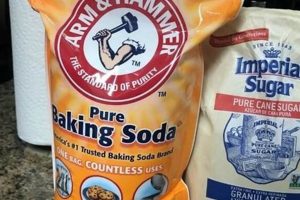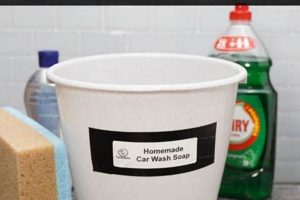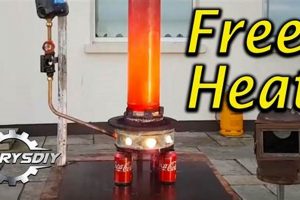A system designed to generate a high-pressure stream of water for cleaning purposes, often constructed using readily available components instead of a commercially manufactured unit, can offer a cost-effective alternative. This approach to outdoor cleaning allows for customized pressure settings and configurations tailored to specific needs. For example, individuals may choose to combine an electric motor, a water pump, and various fittings to achieve a desired level of cleaning power.
The advantages of this approach include potential cost savings, the ability to repair and maintain the system independently, and customization options not available in standard models. Historically, the motivation behind creating such systems stemmed from a desire to overcome the limitations of existing products or to achieve a more affordable cleaning solution. This method also promotes resourcefulness and a deeper understanding of the mechanics involved in generating high-pressure water streams.
The subsequent sections will delve into crucial considerations for constructing such a system, outlining the necessary components, safety precautions, and step-by-step instructions. Detailed guidance on selecting appropriate materials, ensuring proper assembly, and troubleshooting common issues will also be provided. This will enable individuals to safely and effectively build a functional and reliable cleaning system.
Construction and Operation Tips
The following guidelines offer practical advice for the successful construction and safe operation of a self-assembled high-pressure cleaning system.
Tip 1: Pump Selection. Choose a pump rated for the intended pressure and flow rate. Exceeding the pump’s specifications can lead to premature failure or catastrophic damage. For example, a pump designed for 1000 PSI should not be used in applications requiring 1500 PSI.
Tip 2: Motor Compatibility. Ensure the electric motor’s horsepower rating is sufficient to drive the selected pump. Insufficient power will result in reduced pressure and potential motor burnout. Consult pump manufacturer specifications for recommended motor power.
Tip 3: Secure Connections. All fittings and hoses must be rated for the maximum pressure the system will generate and must be securely connected. Improper connections are prone to leaks and can create hazardous high-pressure spray.
Tip 4: Pressure Regulation. Install a pressure regulator to control the output pressure and prevent damage to the pump or connected components. Over-pressurization can lead to component failure and potential injury.
Tip 5: Safety Nozzle. Employ a safety nozzle designed to reduce the risk of injury from high-pressure water jets. The nozzle should be properly sized for the pump’s flow rate to ensure effective cleaning without exceeding safe operating parameters.
Tip 6: Water Source Filtration. Utilize a water filter to remove debris from the water source before it enters the pump. Sediment and other particles can damage the pump’s internal components and reduce its lifespan.
Tip 7: Electrical Safety. Ground the motor and use a Ground Fault Circuit Interrupter (GFCI) outlet to prevent electrical shock. Water and electricity create a dangerous combination, so proper grounding and GFCI protection are essential.
Following these recommendations contributes to a safer and more reliable operational experience. Careful attention to detail during assembly and adherence to safety protocols are paramount.
The subsequent section will present potential applications and considerations for long-term maintenance of a user-built high-pressure cleaning apparatus.
1. Component Selection
The construction of a user-assembled high-pressure cleaning apparatus hinges critically on the selection of appropriate components. Each part directly impacts the overall functionality, efficiency, and safety of the final system. Inadequate component choices can lead to diminished cleaning power, premature system failure, or potential safety hazards. For instance, a pump not rated for the intended pressure will fail to deliver the necessary force, while an undersized motor will struggle to drive the pump effectively, resulting in reduced performance and possible motor burnout. Conversely, selecting oversized components can lead to unnecessary expense and inefficient energy consumption.
Practical examples demonstrate the significance of component selection. The choice of a low-quality hose, unable to withstand the system’s pressure, can result in bursting and potentially dangerous high-pressure water jets. Similarly, selecting an incompatible nozzle can impact the spray pattern and cleaning effectiveness, necessitating multiple passes to achieve the desired result. The decision to use a non-filtered water source can introduce abrasive particles into the pump, accelerating wear and reducing its lifespan. Therefore, careful consideration of the intended use, pressure requirements, and material compatibility is paramount. Furthermore, opting for components that meet industry standards and possess proper certifications enhances reliability and safety.
In summary, component selection is not merely a preparatory step but a foundational element that determines the success or failure of a self-built high-pressure cleaning system. By understanding the interdependence of components and their individual roles, the user can construct a system that is both effective and safe. Challenges in this area include accurately assessing pressure requirements and selecting components that are compatible and appropriately sized. Addressing these challenges through thorough research and careful planning is essential for successful system construction.
2. Pressure Regulation
Pressure regulation is a critical aspect of any user-constructed high-pressure cleaning system. Without effective control over the output pressure, the system risks damaging the surfaces being cleaned or, more seriously, causing physical injury. The uncontrolled release of high-pressure water can strip paint, etch concrete, or even lacerate skin. A properly installed pressure regulator acts as a crucial safety device, limiting the maximum pressure output to a pre-determined level. This ensures that the system operates within safe and effective parameters. Furthermore, maintaining consistent pressure prolongs the lifespan of the system’s components by preventing overstressing the pump, hoses, and fittings.
The implementation of pressure regulation in a user-built system often involves installing a pressure relief valve (PRV) or an adjustable pressure regulator. A PRV provides a fixed pressure limit, automatically diverting water flow if the pressure exceeds the set point. An adjustable regulator allows the user to fine-tune the output pressure to match the specific cleaning task. For instance, delicate surfaces like wood siding may require a lowe
r pressure setting, while tougher grime on concrete necessitates a higher setting. In either case, the presence of a reliable pressure regulation mechanism transforms a potentially hazardous system into a versatile and controlled cleaning tool.
In conclusion, pressure regulation is not merely an optional feature, but an essential safety and performance component of any user-assembled high-pressure cleaning system. It safeguards both the user and the surfaces being cleaned, extends the system’s lifespan, and enhances its versatility. The successful integration of pressure regulation underscores the importance of understanding the fundamental principles of high-pressure hydraulics and the practical application of safety engineering.
3. Safety Mechanisms
The inherent risks associated with high-pressure water systems mandate the incorporation of robust safety mechanisms within any user-assembled cleaning apparatus. These mechanisms serve as a critical line of defense against potential hazards, including component failure, uncontrolled pressure release, and operator injury. The absence or inadequacy of these safeguards directly correlates with an increased probability of accidents and system damage. A practical example is the use of a burst-resistant hose, designed to withstand pressures exceeding the system’s operating limit. Failure to utilize such a hose can result in rupture under pressure, creating a projectile hazard and potential for serious harm.
Further examples of essential safety mechanisms include pressure relief valves, which prevent over-pressurization by automatically diverting water flow; shielded nozzles, which minimize the risk of direct contact with the high-pressure jet; and appropriately rated electrical components, which mitigate the risk of electrical shock. Ground fault circuit interrupters (GFCIs) are particularly crucial in preventing electrocution, as they detect minute current leakage and immediately interrupt the power supply. The selection and proper installation of these safety components are not optional considerations but rather fundamental prerequisites for safe and responsible system operation. A common mistake is to undervalue these elements, prioritizing cost savings over operator safety.
In summary, the integration of appropriate safety mechanisms is paramount to the successful and responsible operation of a user-built cleaning system. These mechanisms act as essential safeguards against the inherent dangers of high-pressure water and electricity. A comprehensive understanding of potential risks, coupled with the diligent implementation of preventive measures, significantly reduces the likelihood of accidents and ensures a safer working environment. The long-term reliability and user safety are inseparably linked to the robustness and effectiveness of the implemented safety protocols.
4. Motor Compatibility
The selection of an appropriate motor is paramount to the functionality and longevity of any self-constructed high-pressure cleaning system. The motor provides the motive force necessary to drive the water pump, and its characteristics must be carefully matched to the pump’s requirements to ensure optimal performance and prevent damage.
- Horsepower Rating
The motor’s horsepower (HP) rating must be sufficient to meet the pump’s torque and speed demands under load. An undersized motor will struggle to maintain the required pressure and flow rate, leading to inefficient cleaning and potential motor burnout. Conversely, an excessively powerful motor may consume more energy than necessary. For example, a pump requiring 2 HP should be paired with a motor rated at least at that level, with a slight buffer for sustained operation. Selecting a motor with insufficient horsepower results in system inefficiency and potential premature failure of both the motor and the pump.
- Voltage and Phase
The motor’s voltage and phase (single-phase or three-phase) must be compatible with the available electrical supply. Using an incompatible voltage can damage the motor and pose a safety hazard. Most residential settings utilize single-phase power, while industrial environments often employ three-phase systems. Operating a three-phase motor on a single-phase supply, or vice versa, will likely result in malfunction or catastrophic failure of the motor. Matching the electrical supply to the motor’s requirements is a fundamental safety and operational necessity.
- RPM (Revolutions Per Minute)
The motor’s RPM must align with the pump’s specified operating speed. Significant discrepancies between the motor’s RPM and the pump’s requirements can lead to inefficient pumping and potential damage to the pump’s internal components. Some pumps may require a direct drive connection to the motor, while others necessitate the use of a gearbox or belt drive to achieve the optimal speed. For example, if a pump is designed to operate at 1750 RPM, the motor should ideally deliver that speed directly or through appropriate speed reduction mechanisms. Mismatched RPMs translate to reduced cleaning effectiveness and potential system damage.
- Motor Enclosure Type
The motor enclosure must be suitable for the operating environment. Motors exposed to moisture, dust, or other contaminants require a sealed or protected enclosure to prevent damage and ensure reliable operation. Totally Enclosed Fan Cooled (TEFC) motors are commonly used in high-pressure cleaning systems due to their resistance to water and debris. An open drip-proof motor, for example, is unsuitable for outdoor applications or environments where water spray is prevalent, as it is vulnerable to water damage and corrosion. Selecting the appropriate enclosure type safeguards the motor from environmental hazards and prolongs its lifespan.
Therefore, careful assessment of motor compatibility is crucial to realizing a functional and durable cleaning system. Failing to adequately consider these factors can lead to suboptimal performance, increased maintenance costs, and potential safety hazards. Matching the motors specifications to the pump’s demands is vital for reliable and efficient operation.
5. Water Filtration
The integration of water filtration into any user-assembled high-pressure cleaning system is not merely an optional addition but a fundamental requirement for ensuring both operational longevity and consistent performance. Particulate matter present in the water supply, such as sediment, sand, and mineral deposits, can inflict significant damage on the internal components of the pump. This abrasive action accelerates wear on pistons, seals, and valves, leading to reduced pressure output, increased maintenance frequency, and ultimately, premature system failure. The lack of effective filtration introduces a direct cause-and-effect relationship: unfiltered water directly damages the pump, shortening its lifespan and diminishing its effectiveness.
The implementation of water filtration can take various forms, from simple inline filters to more elaborate multi-stage filtration systems. A common approach involves installing a sediment filter at the water inlet to trap larger particles before they reach the pump.
More sophisticated systems may incorporate carbon filters to remove chlorine and other chemical contaminants that can corrode metal components. Regularly cleaning or replacing these filters is critical to maintaining their effectiveness. For example, a failure to replace a clogged filter will reduce water flow to the pump, potentially causing cavitation and further damage. The practical significance of this understanding lies in preventing costly repairs and ensuring the system operates reliably for an extended period.
In summary, water filtration stands as an indispensable component of any user-constructed high-pressure cleaning apparatus. Its role extends beyond mere convenience; it is directly linked to the system’s lifespan, performance consistency, and overall reliability. Overlooking this aspect invites a cascade of potential problems, ranging from reduced cleaning effectiveness to catastrophic pump failure. Addressing this critical area requires careful selection of appropriate filtration methods and diligent maintenance to ensure sustained operational integrity.
Frequently Asked Questions
This section addresses common inquiries regarding the construction and operation of user-assembled high-pressure cleaning systems. The information presented aims to provide clarity and guidance for individuals undertaking such projects.
Question 1: Is the construction of a user-assembled high-pressure cleaning system economically advantageous compared to purchasing a commercial unit?
The economic benefit varies depending on the components selected and the user’s pre-existing resources. While potential savings exist, the cost of individual components and the time invested in assembly must be considered. High-quality components will increase the initial investment but may offer greater long-term reliability.
Question 2: What safety precautions are paramount when operating a user-assembled high-pressure cleaning system?
Key safety measures include wearing appropriate personal protective equipment (PPE), such as eye protection and closed-toe shoes; ensuring all connections are secure and leak-free; and never directing the high-pressure stream towards oneself or others. Ground Fault Circuit Interrupters (GFCIs) are essential to prevent electrical shock. Regular inspection of all components for wear or damage is also crucial.
Question 3: What factors influence the pressure output of a user-assembled high-pressure cleaning system?
The pressure output is primarily determined by the pump’s pressure rating and the motor’s horsepower. The nozzle size also affects pressure; smaller nozzles generally result in higher pressure, but reduced flow. Pressure regulators allow for adjustment of the output pressure to match the specific cleaning task.
Question 4: How does water filtration impact the longevity of a user-assembled high-pressure cleaning system?
Water filtration is crucial for preventing damage to the pump’s internal components. Particulate matter in the water supply can cause abrasive wear on pistons, seals, and valves, leading to reduced performance and premature failure. Utilizing a water filter significantly extends the system’s lifespan.
Question 5: What maintenance procedures are recommended for a user-assembled high-pressure cleaning system?
Regular maintenance includes inspecting hoses and fittings for leaks or damage, cleaning or replacing water filters, lubricating pump components (if applicable), and storing the system properly when not in use. Following the pump manufacturer’s recommendations for maintenance intervals is advisable.
Question 6: Can chemical detergents be used with a user-assembled high-pressure cleaning system?
The compatibility of chemical detergents depends on the materials used in the system’s construction, particularly the pump and hoses. Some detergents can corrode or degrade certain materials. Consult the component manufacturers’ specifications before using any detergent. A dedicated detergent injector may be necessary for proper application.
In summary, the successful and safe operation of a user-assembled high-pressure cleaning system requires careful planning, diligent assembly, and adherence to safety protocols. Understanding the factors that influence performance and implementing appropriate maintenance procedures are essential for maximizing the system’s lifespan and effectiveness.
The following section will explore advanced modifications and potential upgrades for enhancing the capabilities of a self-built high-pressure cleaning apparatus.
Conclusion
This exploration of “diy pressure washer” systems has highlighted several critical aspects. Component selection, pressure regulation, safety mechanisms, motor compatibility, and water filtration each contribute significantly to the functionality, safety, and longevity of a user-built apparatus. Neglecting any of these areas can lead to reduced performance, increased risk of accidents, and premature system failure. The information presented serves as a guide for individuals considering constructing such a system, emphasizing the need for careful planning and diligent execution.
The creation of a functional and safe system demands a thorough understanding of high-pressure hydraulics, electrical safety, and material compatibility. While the potential for cost savings exists, the ultimate success hinges on the user’s commitment to quality, safety, and ongoing maintenance. Thoughtful application of this knowledge will ensure the responsible and effective utilization of a “diy pressure washer”.







